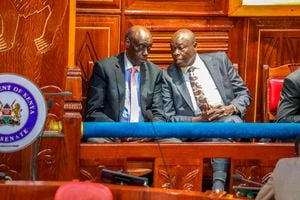Fitch downgrades Kenya on high debt, low forex reserves

Kenya is riddled with Sh8.7 trillion of both domestic and external debt.
Fitch Ratings has downgraded Kenya’s credit rating from ‘B+’ to ‘B’ attributing the action to the country’s growing mountain of debt and depleted foreign exchange reserves.
The company said Kenya faces extra strain on its foreign reserves driven by elevated external debt servicing obligations in the financial year 2023/24 including the maturity of the $2 billion (Sh245.82 billion) Eurobond in 2024 combined with high current account deficits.
Kenya is riddled with Sh8.7 trillion of both domestic and external debt equivalent to 62 per cent of the country’s gross domestic product (GDP).
“The downgrade reflects Kenya's persistent twin fiscal and external deficits, relatively high debt, and deteriorating external liquidity, and high external financing costs, which presently constrain access to international capital markets,” said Fitch.
Kenya’s debt servicing costs remain high, and the National Treasury will spend Sh1.393 trillion to service both principal and debt interest in the current financial year.
This is an increase from the Sh1.151 trillion debt servicing obligations that was spend to service debt in the previous financial year.
The payment consists of Sh690 billion in interest payment on debt in addition to the Sh461.4 billion it will spend on redeeming internal debt and Sh241 billion in external debt redemption.
The debt burden has exerted a huge burden on the exchequer forcing the Treasury to restructure part of its short-term domestic debt.
This as investors bid for only 60.25 per cent of the Treasury bills and bonds the government was offering to swap with a longer-term infrastructure bond.
The Treasury was seeking to swap Sh87.8 billion worth of short-term debt with longer term debt to create breathing space to fund the government’s growing spending needs amidst a tight fiscal environment.
However bids totaling worth only Sh52.9 billion were received from investors by the deadline of November 30.
The external debt payment obligations and a growing import bill have depleted Kenya’s foreign exchange reserves which recently saw the reserves drop below the statutory level of at least four months of import cover.
“The usable foreign exchange reserves remained adequate at $7.1 billion (3.98 months of import cover) as at December 8. This meets the CBK’s statutory requirement to endeavor to maintain at least 4 months of import cover,” said CBK last week.
Fitch forecasts the current account deficit to grow to 5.9 per cent of the GDP ($6.9 billion or Sh848 billion) in 2022 and to remain at broadly the same levels in 2023 and 2024 even as currency depreciation has increased Kenya's external interest servicing costs.
“We forecast external debt service to rise to 24.8 per cent of current external receipts in 2024, up from 16.6 per cent in 2023, owing to the June 2024 $2 billion Eurobond payment. Currently, our base case assumes that the government will meet its external debt obligations of $3 billion (Sh368.7 billion) in the fiscal year ending June 2023 (FY23) through a combination of official and commercial borrowing,” said Fitch.
Stable outlook
Fitch has however given Kenya a ‘stable’ outlook based on the country’s fiscal consolidation efforts driven by the International Monetary Fund (IMF), manageable near-term debt commitments and strong post-pandemic growth that is likely to continue over the medium term.
“Fitch expects Kenya's growth to remain steady in 2023 and 2024 following strong post-pandemic growth recovery. Growth has been mixed this year, with drought lowering output in the agricultural sector during the early part of it and the August 2022 general election contributing to an expected slowdown in 3Q22. We forecast real GDP growth of 5.4per cent in 2022, down from 7.5per cent in 2021.”





